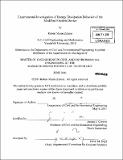Experimental investigation of energy dissipation behavior of the modified friction device
Author(s)
Zahner, Robert Marne
DownloadFull printable version (8.204Mb)
Other Contributors
Massachusetts Institute of Technology. Dept. of Civil and Environmental Engineering.
Advisor
Jerome J. Connor.
Terms of use
Metadata
Show full item recordAbstract
As building materials become stronger, dynamic design and structural control are effective means of improving serviceability in the future's ever lighter structures. The recently proposed modified friction device (MFD) addresses many of the concerns that have prevented the building industry from fully embracing non-passive control: the device is based on the drum brake, a reliable technology that is inexpensive, already mass manufactured, capable of producing very large damping forces, and has such low power inputs that it can be run from a battery in the event of a power outage. Preliminary studies have shown that an MFD-based control scheme is at least as effective as an existing system that uses dampers capable of the same maximum force. The goal of this thesis was to better understand the MFD's energy dissipation behavior. Previous investigations have studied the behavior of friction devices subject to the types of low frequency excitations but not under loads with low frequencies and small displacements. This research sought to provide insight into the behavior of the MFD under real-world conditions by building and testing the variable friction element used in the MFD. To that end, a testing apparatus for a variable friction element was built from an automotive drum brake; the design, building process, and testing are described in detail. While data indicate that an adjustment may need to be made to previous friction models used for the MFD, the physical limitations of the device created for the study prevent this research from reaching conclusive results regarding friction behavior of the MFD. However, experienced gained allows for conclusions about the design of the MFD. Effectively converting linear motion into rotation in the drum is crucial to the MFD's operation: without this, the brake cannot dissipate energy. The design used for this study used friction between the drum and the face of a column to rotate the brake; this friction was not sufficient to prevent slippage. Instead of relying on friction, future MFD designs should utilize a gear or other more mechanically robust system to generate rotation in the drum.
Description
Thesis (M. Eng.)--Massachusetts Institute of Technology, Dept. of Civil and Environmental Engineering, 2011. Cataloged from PDF version of thesis. Includes bibliographical references (p. 50).
Date issued
2011Department
Massachusetts Institute of Technology. Department of Civil and Environmental EngineeringPublisher
Massachusetts Institute of Technology
Keywords
Civil and Environmental Engineering.